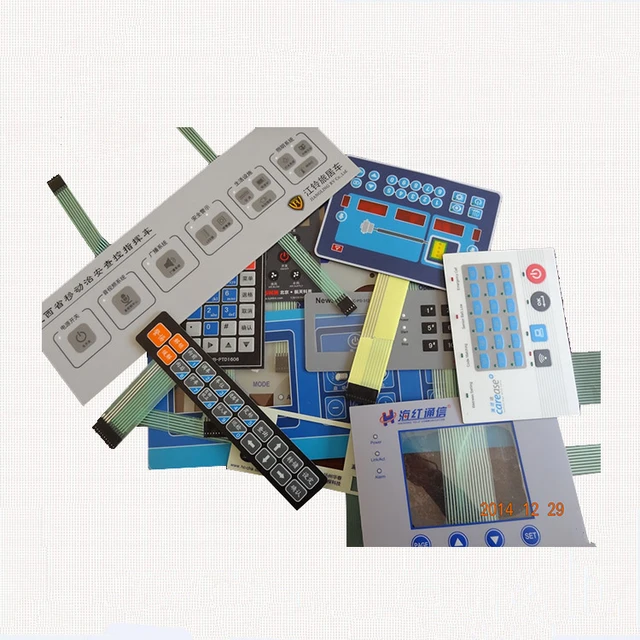Choosing the Right Membrane Switch for Your Business Needs
Choosing the Right Membrane Switch for Your Business Needs
Blog Article
Recognizing Membrane Switches Over: The Key to Trustworthy and long lasting Controls

What Are Membrane Layer Buttons?
Membrane buttons are an advanced solution in the world of interface innovation, incorporating performance and style perfectly. These gadgets offer as a user interface between users and digital systems, integrating several parts into a portable layout. Commonly built from versatile, thin layers of materials, membrane layer buttons are designed to respond to touch, allowing individuals to communicate with machinery and digital tools effectively.
The key components of a membrane button consist of a printed circuit layer, graphic overlay, and a spacer layer that stops unintentional activation. The visuals overlay can be personalized to show brand name identity or individual choices, boosting aesthetics while making sure use. Membrane buttons are commonly used in numerous applications, including clinical tools, consumer electronic devices, and commercial equipment, owing to their toughness and resistance to ecological elements such as dampness and dust.
Among the vital benefits of membrane buttons is their capability to withstand damage, making them optimal for high-traffic environments. Additionally, they are lightweight and call for minimal space, enabling ingenious styles in item development. Generally, membrane layer switches stand for a effective and useful choice for contemporary digital interfaces, weding technology with user-centric style concepts.
Exactly How Membrane Layer Switches Work
The procedure of membrane switches over joints on a straightforward yet reliable device that translates customer input into electronic signals. These switches include multiple layers, generally including a graphic overlay, a spacer layer, and a circuit layer. When an individual presses the switch, the top layer warps, permitting a conductive component in the circuit layer to make call with a matching conductive pad on the bottom of the graphic overlay. This get in touch with shuts the circuit and sends a digital signal to the tool, indicating that the button has been turned on.
The design of membrane buttons can vary, yet they typically incorporate domes or responsive elements to give comments to the user, enhancing the total experience - membrane switch. The materials used in membrane buttons, such as polyester or polycarbonate, contribute to their resilience and resistance to ecological variables, including wetness and dust. The printed circuits are normally enveloped, which protects them from wear and tear over time.
Advantages of Membrane Layer Switches

Furthermore, membrane layer buttons are recognized for their toughness. Created from durable materials, they are immune to dust, moisture, and physical wear, which significantly extends their life expectancy compared to typical mechanical buttons. This resilience makes them specifically ideal for high-traffic settings and applications needing durability.
One more substantial advantage is the ease of cleansing and maintenance. The smooth surface of membrane layer switches minimizes dust buildup and is frequently impervious to spills, making them optimal for setups that require regular sanitization.
Additionally, membrane switches supply a structured profile, resulting in a thinner layout that can be integrated right into different devices without adding mass. This function not only improves the aesthetic allure yet also adds to a more ergonomic item design.
Applications of Membrane Buttons
Straightforward and versatile, membrane layer switches discover applications throughout a large range of markets, consisting of medical tools, consumer electronic devices, and commercial tools. In the clinical field, these buttons are indispensable to devices such as analysis equipment, patient tracking systems, and mixture pumps, where dependability and ease of cleaning are essential. Their ability to maintain and stand up to extreme atmospheres capability makes them ideal for such applications.

In consumer electronic devices, membrane layer switches are utilized in products like microwaves, cleaning makers, and push-button controls - membrane switch. Their smooth layout enables intuitive interface, enhancing the general individual experience while giving longevity and resistance to tear and put on
Industrial tools additionally takes advantage of membrane layer buttons, particularly in control panels for machinery and automation systems. These switches provide defense versus click for more info dirt and dampness, making certain regular efficiency in challenging settings. Their personalized features permit suppliers to customize them to particular functional demands, improving efficiency and capability.
Selecting the Right Membrane Layer Change
When selecting a membrane switch, it is vital to think about various elements that affect efficiency and suitability for specific applications. The primary factors to consider consist of ecological conditions, tactile comments, longevity, and layout specs.
First, assess the operating environment; switches subjected to moisture, chemicals, or severe temperatures need particular products to ensure durability and capability. Next off, examine the demand for tactile feedback. Depending upon customer interaction, some applications might benefit from a responsive response to verify activation, while others may prefer a non-tactile design for visual reasons.
Toughness is one more important element; membrane buttons should be created to withstand constant use, impacts, and abrasion. Make certain the selected button can endure the anticipated lifecycle, especially in high-usage circumstances.

Conclusion
In verdict, membrane layer changes serve as crucial elements in the design of sturdy and reputable control systems across various sectors. The versatility of membrane changes permits for customized services that fulfill particular operational requirements, enhancing their importance in modern-day technology.
Membrane switches represent a vital aspect of modern user interface layout, blending performance with strength in different applications.Membrane buttons are an advanced solution in the realm of user interface innovation, combining capability and design perfectly. Usually created from versatile, thin layers of products, membrane switches are designed to respond to touch, enabling individuals to communicate with equipment and electronic tools successfully.
The design of membrane buttons Learn More Here can differ, but they frequently include domes or responsive elements to supply comments to the customer, enhancing the overall experience.In final thought, membrane switches offer as essential parts in the layout of reputable and sturdy control systems throughout different markets.
Report this page